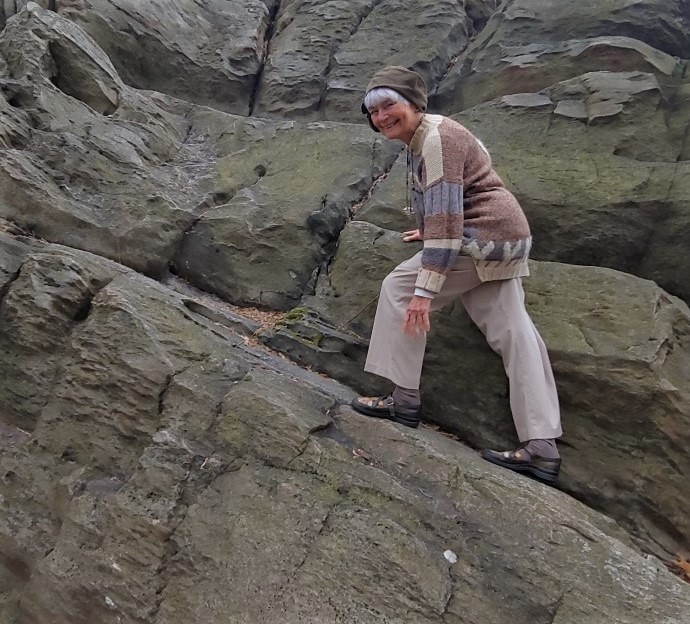A closer look at Graystones where Bucks County and Pennsylvania began.
Before the current social distancing emergency, I mentioned to a family friend the deed to her home traces back to primordial bedrock in Morrisville. Same for my house on the other side of town. In fact, the deed to every shop in Newtown, Langhorne and Bristol goes back to Graystones. Every townhouse in Middletown and Lower Makefield too. Plus colonial homes in Yardley, new mansions in Upper Makefield and farms in Wrightstown. Wynne was intrigued so I suggested a mini-adventure: Drive out to Graystones, climb it, imagine how the First Deed was consummated there in 1682. Cool! Off we went.
First stop was William Penn’s mansion on the Delaware River in Falls five miles below Graystones. There we peeked at historical records including a copy of the first indenture. We also learned Penn created a footpath to Graystones; the founder loved a good stroll.
The silvery gray bedrock is located at the intersection of Crown Street and Highland Avenue, a prime Morrisville locale of stately homes around a brownstone monument fronting the jagged singularity. The Bucks County Historical Society established the marker in 1929 to commemorate Penn’s first land purchase from Native Americans. The monument and Graystones overlook a forested slope dropping precipitously 200 feet to River Road (Route 32) and Delaware River rapids. You have to go back in time to understand what happened there in 1682.
Penn had secured title to Pennsylvania from England’s King Charles II. The new colony embraced a massive territory of unbroken woodlands between New York and Maryland. Penn faced a formidable administrative task of creating harmony between Indians and soon-to-be immigrants from England and Europe. His aim was to codify peaceful co-existence between both sides. As he advised, “Be tender of offending the Indians…To soften them to me and the people, let them know you are come to sit down lovingly among them…Be grave, they like not to be smiled on.”
Before sailing from London, Penn sent ahead his first cousin to get things started. William Markham, 47-year-old captain in the British Army, was designated acting governor until Penn’s arrival the following year. On Aug. 3, 1681 Markham landed in the only town in the colony, Upland (today’s city of Chester). One of his first tasks was to find a place on the river estuary to build the Penn family mansion, which he did in Falls. His orders also included buying from the indigenous Lenni Lenape tribe an 83,000-acre tract of land that would include Penn’s home and 8,000-acre Pennsbury Manor. The rest would be sold to speculators, subdivided and sold off to immigrants. Markham and his aides in ceremonial dress met with tribal chiefs at Graystones to consummate the colony’s first surveyed land purchase.
The resulting deed defined the boundary beginning at Graystones and proceeding upriver 9 miles to Knowles Creek (today’s Jericho Creek). The confluence is just above where George Washington made his famous crossing of the Delaware in 1776. Markham’s surveyors followed Knowles Creek west to Neshaminy Creek in Wrightstown, then down the Neshaminy to the Delaware. The line turned north on the river past Penns’s manor to the starting point at Graystones. The purchase enclosed 130 square miles to be called Buckingham Shire (later Bucks County). The deed today defines where 180,000 citizens live in Upper and Lower Makefield, Wrightstown, Newtown Township and Borough, Langhorne, Langhorne Manor, Penndel, Hulmville, Middletown, Bristol Township and Borough, Tullytown, Morrisville and Falls.
The document guaranteed rights to Lenape Indians to move freely and live, grow crops and hunt in the shire. Penn arranged payment for what the tribe considered priceless: a liberal amount of cash, trading beads and merchandise believed to have included hairy wool match-coats, petticoats, narrow hoes, knives, hunting rifles, axe blades, fish hooks, pipes, tobacco tongs, combs, scissors, red paint, needles, gun powder and rum.
It took centuries before people realized the historical significance of Graystones and put up the memorial in 1929. But nothing secured the stone and old growth forest behind it from development. In the 1990s, a builder proposed turning the entire site into a dense, hill-side condominium complex. Fortunately, reporter Patricia Wandling of the Bucks County Courier Times newspaper uncovered the plan and wrote about it. That propelled community action to obtain permanent protection for Graystones and its 6-acre forest.
These days, it’s a joy for my grandchildren and friends like Wynne to visit Graystones. Wynne is impressed by the pristine setting where local residents, as she put it, “must be aware, watchful and protective about the rock of ages in their backyard. There is something about the site that demands respect and awe.” Reading the tableau on the monument and climbing the metamorphic rock is to contemplate the very beginning of our beautiful state.
Sources include the Pennsbury Manor museum, 400 Pennsbury Memorial Road, Falls tonwship, and “Graystones: The Treaty of Pennsylvania” at https://buckscountyintime.wordpress.com/2012/03/26/

